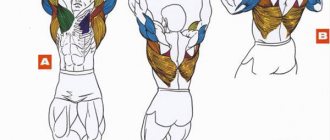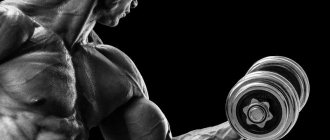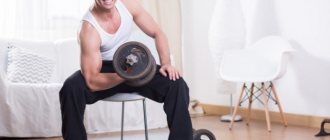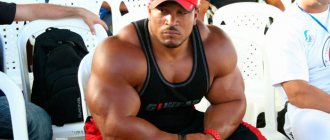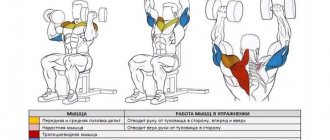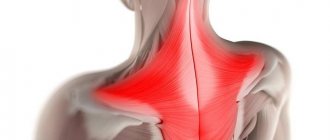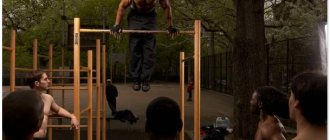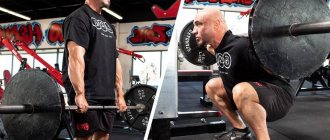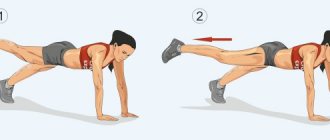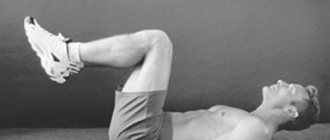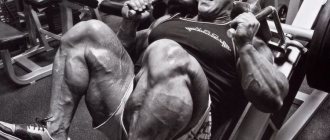- September 15, 2018
- Home workouts
- Nikita Novikov
Is it possible to pump your legs every day? This question is usually asked by beginners who are just about to sign up for a gym. If you are reading these lines now, then it is quite possible that you are one of them. In this case, we invite you to read our publication, which covers this topic in detail. After reading it, you will not only learn whether it is possible to pump your legs every day, but also understand on what principle it is necessary to draw up a training program. Interested? Then start reading quickly!
Bodybuilding every day
Let’s not beat around the bush, but let’s say it straight away: no, you can’t pump your legs every day. This applies not only to the legs, but also to all other muscles of our body. Exercising too frequently will quickly push the body into a state of overtraining.
Of course, a lot depends on the loads received during the training sessions. For example, you can allocate one muscle group for one day: on Monday - biceps, on Tuesday - chest, on Wednesday - triceps, etc. But such a training system is considered more effective for professional athletes, and not for the average gym goer. hall For the latter, the split system is more effective, in which several muscle groups are worked out during training, since this better stimulates the production of anabolic hormones. To summarize all of the above, then 3 workouts per week with breaks of 1-2 days between them will be more effective than 7 workouts per week for each muscle group.
What exercises to do for the back of the thigh
The biceps femoris, semimembranosus and semitendinosus muscles are located here. They extend the thigh and flex the lower leg.
Deadlift
Pumps HAMSTRINGS, QUADRICEPS, AND GLUTEAL MUSCLE ACTIVATION DURING RESISTANCE TRAINING EXERCISES, Muscle activation during lower body resistance training the entire back surface of the body: back extensors, buttocks, hamstrings and calves.
Walk up to the barbell and stand so that the bar is positioned above the laces of your sneakers. Place your feet shoulder-width apart and turn your toes slightly to the sides. Move your pelvis back, bend over with a straight back and grab the bar so that your palms are shoulder-width apart.
Keeping your back straight, straighten your body and stand straight with the barbell in your hands. Bring the bar very close to your shins, then the bar will follow an ideal trajectory. After straightening, lower the apparatus to the floor and repeat the exercise.
The back of the thigh is pumped approximately equally in any type of deadlift. By changing the execution, you can increase the load on other muscles:
- Stiff-legged deadlifts better develop Electromyographic Activity of Lower Body Muscles during the Deadlift and Stiff-Legged Deadlift calf muscles.
- The sumo deadlift better loads An electromyographic analysis of sumo and conventional style deadlifts on the front of the thigh: the lateral and medial heads and the front of the lower leg.
Hull lifts on GHD
Good for muscle activation during various hamstring exercises, Kettlebell swing targets semitendinosus and supine leg curl targets biceps femoris: An EMG study with rehabilitation implications of the hamstrings, as well as the buttocks and back extensors.
Place your feet under the rollers of the machine, extend your body parallel to the floor, and place your hands behind your head. Lower your body, keeping your back straight, and then rise until it is parallel to the floor or slightly higher.
To make the exercise more challenging, add free weights. If you need weighting up to 5 kg, take a weight plate and hold it next to your head; if more, place a bodybar, barbell or barbell on your shoulders.
Good morning
Good loads Muscle activation during various hamstring exercises and stretches the back of the thigh, pumps up the back extensors.
Place your feet shoulder-width apart, pointing your toes forward. Place the barbell on your shoulders, straighten and slightly arch your back. Bend your knees slightly, move your pelvis back and tilt your body forward until it is parallel to the floor. Straighten up and repeat.
Here it is important to move your pelvis back and keep your back straight. If you don't have enough stretch to do this exercise correctly, replace it with another one.
Bulgarian split squat
Split squat pumps up the hamstrings better. Comparison of lower extremity EMG between the 2-leg squat and modified single-leg squat in female athletes, Hip-Muscle Activation During the Lunge, Single-Leg Squat, and Step-Up-and-Over Exercises , Muscle Activity in Single- vs. Double-Leg Squats than regular squats, lunges and step-ups.
Stand with your back one step away from a small elevation, such as a bench. Place one sock on a raised platform and squat down until your thighs are parallel to the floor. Straighten up and repeat.
First try a split squat without weights. If you can maintain your balance, you can take dumbbells or squat with a barbell on your shoulders.
Bend forward on your knees
Perfectly loads Muscle activation during lower body resistance training, Kettlebell swing targets semitendinosus and supine leg curl targets biceps femoris: An EMG study with rehabilitation implications of the posterior thigh. If possible, do it with a partner; if not, try putting your feet under a machine or rack. Just don't forget to place a rug under your knees.
Fix your legs, stretch your body and hips in one line. Lean forward as much as possible. But only as much as it is possible to maintain a straight body position and not bend at the hip joints. Get back up and repeat.
How much time do muscles need to rest?
Our muscles can be divided into two groups: large and small. The first group includes the legs, back and chest, the second group includes the biceps, triceps, calves and deltoids. To know how often to lift your legs for mass, you first need to understand that large muscle groups need more time to recover than small ones. This, as one might understand, is due to their size.
The amount of work put in during a training session also plays a big role. The longer and harder you train a muscle group, the more rest it needs to fully recover.
The last important point is your general level of physical fitness. On the one hand, the longer you train, the better your muscles adapt to various types of loads. On the other hand, the larger your muscles become, the more time they need to recover. Such is the paradox.
What to do on recovery days?
The recovery period does not mean total laziness and lying on the couch. Light training is recommended on these days. This could be stretching or some light cardio (brisk walking, cycling).
Regular stretching can increase blood circulation. This ensures sufficient blood flow to the muscles, which helps reduce recovery time and reduces muscle soreness after intense exercise.
It has been proven that after complete recovery, a period of supercompensation begins, during which functional capabilities exceed the initial level. During this period, muscles grow faster.
You should also pay due attention to sleep. During the deep sleep phase, the hormone somatotropin is released, due to which muscle tissue is restored faster, and the level of the stress hormone cortisol, on the contrary, decreases. Without proper rest, the next workout can become counterproductive, as problems with concentration and performance inevitably arise as the nervous system is depleted.
Individual stress, serious physical or mental stress at work, and a poor diet can also lead to under-recovery.
The secret that bodybuilders hide
It is possible that people who are interested in how often per week to work out their legs and buttocks were surprised when reading the above information. It is quite possible that someone even objected: “But Arnold Schwarzenegger trained every day, that’s why he achieved such impressive results in bodybuilding!” This is true; Arnold, like all professional bodybuilders, practiced daily training. But you should understand that experienced bodybuilders use dangerous anabolic steroids, which increase endurance several times and stimulate muscle growth. Also, if you think that they were training every day all the time, then you are very mistaken. As a rule, they resorted to such intensive training only 3-4 weeks before the competition.
Decide on your training goal
When it comes to setting fitness goals, one of the biggest mistakes is that people expect to see results here and now, preferably after the first workout. But trying to tackle everything at once is doomed to failure from the start.
As a rule, the main goals of visiting fitness centers and gyms come down to the following:
- Keeping your body in good shape
- Weight loss
- Muscle building
Having a measurable goal allows you to track progress, and the more specific it is, the clearer the path to achieving it becomes. For example, wanting to “get stronger” is a great start, but what does that mean? Try to think more specifically. Set yourself the task of learning to do 20 push-ups in a minute in a month or run 5 km without stopping in 2 months. This will set a specific time frame and help increase efficiency.
Example training program
As mentioned earlier, for people who train naturally, a three-day split is best. This system looks something like this:
- Monday: chest and biceps.
- Wednesday: back and triceps.
- Friday: legs and shoulders.
How often should you exercise your legs to grow? As you already understood, one hard and intense workout per week will be enough. Since the legs are a large muscle group, it takes a lot of time and effort to work them. If legs are a priority part of the body for you, then you can set aside a separate day for training them.
Leg press
Technique:
- Sit on the machine and place your feet on the platform.
- Press your pelvis and lower back tightly against the cushion and back of the machine.
- Place your feet at the top of the platform and place them slightly wider than your pelvis, with your toes pointed to the sides at an angle of 45 degrees.
- Bend your knees and smoothly lower the platform, keeping your pelvis and lower back intact.
- As you exhale, squeeze the platform powerfully. Make sure your knees move in the direction of your toes.
What do you need to know?
Depending on where we want to direct the load, the feet on the platform are positioned differently. For example, the lower we place our feet, the more the quadriceps is loaded. If we put our legs together, then the outer part is loaded, if we put it wide, the inner part is loaded. If your feet are in the center of the platform, then the load is distributed evenly between the biceps and quadriceps of the thigh (i.e., its lower and upper surfaces). And if you place your legs high, the back of the thigh and buttocks work more.
Photo: istockphoto.com
How long should a leg workout last?
If you work out using a split system and work out two muscle groups in one day (for example, legs + shoulders), then the class should last no more than an hour. Training always releases cortisol and other catabolic hormones responsible for the destruction of muscle fibers. If you delay the time of their release, then recovery from such stress will greatly slow down due to the slowdown in the release of anabolic hormones, including testosterone.
You need to rest for 60-90 seconds between sets. Why is that? It's simple: this mode will allow you to do much more work in a training session than if you rested three minutes between sets. This is exactly the essence of bodybuilding when compared to powerlifting. Muscles grow better from volume work with medium weights, and strength, on the contrary, grows from low-volume work with heavy weights. If you don’t have enough time to recover, you can rest longer.
What exercises to do for the front of the thigh
Here are the quadriceps, the large muscles of four heads. The quadriceps extends the lower leg, and its central head, the rectus femoris, also flexes the thigh.
Back Squats
The exercise uses the muscles of the legs and core, and puts a good load on the front of the thigh.
Take the barbell from the racks, squeeze your shoulder blades together, straighten your chest, straighten your back. Place your feet shoulder-width apart and turn your toes slightly to the sides. Move your pelvis back and squat until your thighs are parallel to the floor. During this process, do not lift your heels off the floor and do not lie with your stomach on your knees.
As you come out of the squat, don't bring your knees together. Look straight ahead and concentrate on working your muscles.
Front Squats
Effectively pumps up A biomechanical comparison of back and front squats in trained healthy individuals the front side of the thigh, especially the inner Kinematic and EMG activities during front and back squat variations in maximum loads part (medial head). Such squats are safer for the knees and lower back than the version with weight on the back.
Remove the bar from the racks, bring your elbows forward, arch your back. Place your feet shoulder-width apart and turn your toes slightly to the sides. Squat until your thighs are parallel to the floor or slightly lower and rise back up.
Lunges
Well loaded HAMSTRINGS, QUADRICEPS, AND GLUTEAL MUSCLE ACTIVATION DURING RESISTANCE TRAINING EXERCISES, Muscle activity during leg strengthening exercise using free weights and elastic resistance: Effects of ballistic vs controlled contractions the entire front surface of the thigh.
If you have trouble keeping your balance in this exercise, try back lunges: they are easier, but less effective. Comparative Analysis of Lunge Techniques: Forward, Reverse, Walking Lunge.
You can do lunges with different weights: with a barbell on your shoulders, with dumbbells in your hands, with an expander band. To begin with, it is better to try dumbbells: it will be easier to maintain balance.
Stand up straight, take weights in your hands, straighten your shoulders, straighten your back. Lunge forward, do not touch the floor with the knee of your back leg: leave a space of 5-10 centimeters between them. Straighten up and repeat on the other leg.
Some people do lunges while walking around the gym. If your goal is to burn more calories and strengthen your core muscles, they can be helpful. But they pump up the hips worse than lunges forward in place.
Leg press in the gym
Same as squats, but with minimal stress on the core muscles and back extensors. Due to this, you can take more weight without risking breaking your back, and better load your hips. In addition, the leg press pumps up the front of the thigh just as effectively Quadriceps EMG/force relationship in knee extension and leg press as the leg extension in the simulator, but does not load the knees as much.
Sit on the exercise chair, press your lower back to the back and do not lift it until the end of the exercise. Place your feet at the bottom of the platform: this position maximizes the load on the front of the thigh. High stance of the legs provides more load on the buttocks.
Under the weight of the platform, bend your legs to a right angle at the knees, and then press it back. At the extreme point, do not straighten your knees completely, leave them slightly bent.
Results
Is it possible to pump your legs every day? Let's summarize all of the above to give a final answer to this question:
- The legs are a large muscle group that takes a long time to recover. It follows that it does not need to be trained more than once a week.
- It makes no sense to train like professional bodybuilders because they use steroids.
- The best training regimen for a natural is a three-day split.
- The training session should last no more than 60 minutes.
- If legs are a priority for you, you can train them on a separate day.
Now you know whether it is possible to pump your legs every day.
What exercises to do for the lower leg muscles
The shape of the lower leg is determined by the gastrocnemius and soleus muscles. To load the Isolated Gastrocnemius Tightness calf muscle, you need to extend your feet with straight knees, but the soleus is better activated when your knees are bent at a right angle.
In addition, speed matters: the gastrocnemius reacts better to fast movements, the soleus - to slow ones.
Single leg calf raises
The exercise is greatElectromyographic Analysis of the Triceps Surae Muscle Complex During Achilles Tendon Rehabilitation Program Exercises targets the calf muscles.
Stand with your toes on the plate, lift one leg. Get up on your toes and lower back down. Gradually increase the range, dropping your heel a little lower. If you have good balance, you can pick up dumbbells.
Standing calf raises
ExerciseElectromyographic Analysis of the Triceps Surae Muscle Complex During Achilles Tendon Rehabilitation Program Exercises on the calf muscle. You can perform it in a special machine or simply with a barbell on your shoulders. Quickly rise up onto your toes and lower back down.
Seated calf raises
This variation works well on the Isolated Gastrocnemius Tightness muscles, so perform the lifts slowly. You can do the exercise in a machine or with a barbell on your knees.
If you choose the barbell option, place a weight plate under your socks to increase the range of motion and stretch the muscles at the bottom. Also, place a cushion on the bar, otherwise it will dig into your legs.
We pump up our legs with lunges and extensions in the simulator
Leg straightening is a useful exercise for the legs, both in warm-up and for work during the main workout. Since this is a growth exercise, you must be extremely careful. It seems simple, but many athletes get burned by it. Straighten your entire leg from your quads to your calves.
Leg straightening in the simulator
How you do this is another important question. Extension is carried out by tensioning the quadriceps, but also try to simultaneously pull your feet up. Make sure your back is firmly pressed into the seat and your hips are not lifting off.
And of course, don’t ignore lunges if you want to quickly build up your leg muscles. You will be surprised, but many people do this exercise incorrectly.
When performed correctly, a clear line is drawn not only in the quadriceps, but also in the hamstrings, and the shape of the buttocks also improves, which is especially important for girls.
Additional leg workout
Let’s summarize all our thoughts on the topic in the final complex:
- Barbell squats, 6 sets: 15, 15, 12, 10, to failure, to failure.
- Deep squats with a barbell, 3 sets: 15, 12, 10 times.
- Lunge with dumbbells forward, 3 sets: 18, 15, 12 times.
- Lunges with a barbell, 4 sets of 40-60 repetitions on each leg.
- Leg straightening in the simulator 3 approaches: 18, 15, 12 times.
The benefits of running
Does running strengthen your legs? Such training allows you to pump up and strengthen your muscles, since they are well used in this sport. By using various techniques and increasing the load over time, you will be able to eliminate excess weight and muscle mass will increase.
If you run long distances, you won’t be able to gain noticeably sculpted muscles, since your legs will only be resilient and neat. To pump them up, you need to perform the above exercises.
